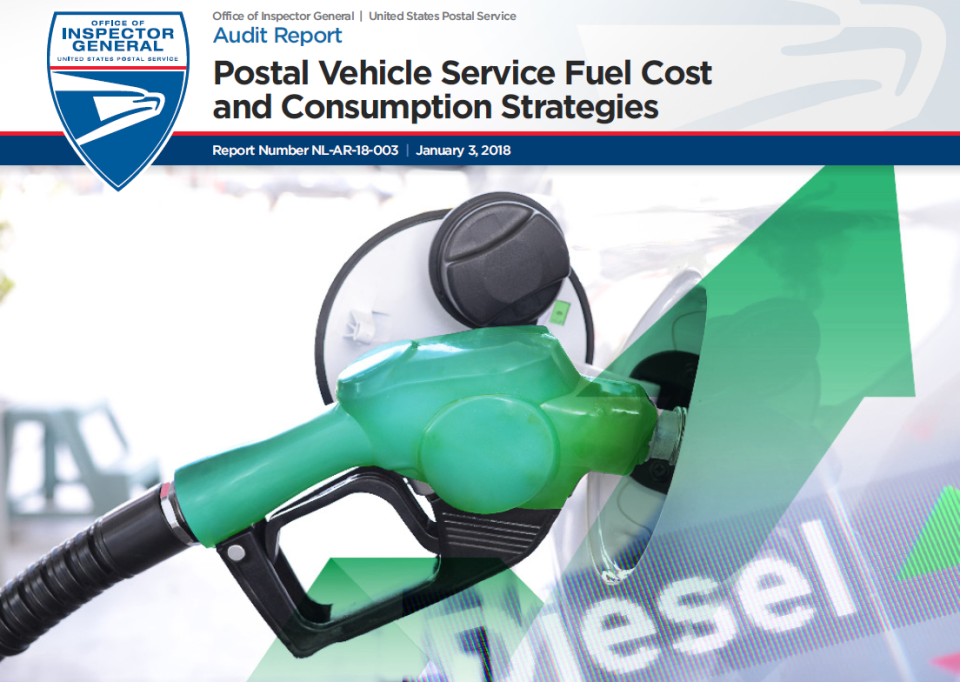Postal Vehicle Service Fuel Cost and Consumption Strategies
Objective
Our objective was to evaluate the effectiveness of Postal Vehicle Service (PVS) fuel cost and consumption strategies.
The PVS fleet moves mail between U.S. Postal Service processing facilities, inner-city delivery offices, and local businesses and mailers. The usual travel distance is about a 50-mile radius of their Postal Service location. The PVS fleet currently consists of 2,152 cargo vans, 1,799 tractors, and 375 spotter vehicles.
What the OIG Found
We found that PVS fuel cost and consumption strategies could be improved. Specifically, the Postal Service does not have a specific PVS plan for reducing its reliance on petroleum-based fuels or integrating technologies such as telematics, which collects, records, and transmits vehicle data to improve fuel efficiency.
The Postal Service has initiatives such as Zero Based Reviews, Dynamic Route Optimization, and Enterprise Transportation Analytics in place to reduce PVS miles driven. However, the Postal Service does not have a specific plan for how it will reduce the PVS fleet’s reliance on diesel fuel, reduce greenhouse gas (GHG) emissions, and increase the use of alternative fuels. The Postal Service also did not include a petroleum-based fuel target for the PVS fleet in its fiscal year (FY) 2016 Strategic Sustainability Performance Plan.
The Postal Service is planning to replace 2,517 PVS vehicles (2,141 cargo vans and 376 spotters) during FYs 2018 and 2019. Management considered Alternative Fuel Vehicles (AFV) for those replacements, but decided not to purchase any AFVs because the additional cost of Compressed Natural Gas (CNG) vehicles could not be recovered within the projected vehicle useful life of eight years. However, our analysis determined that the Postal Service, on average, uses PVS vehicles for about 13 years.
We identified 433 PVS vehicles which are beyond their service life at seven Postal Service sites that offer the best opportunity for a CNG purchase. The vehicles assigned to these sites consume between 297,000 to 516,000 diesel gallons annually and are within a five-mile radius of a public CNG fueling station. By purchasing 433 CNG replacement vehicles at these locations, the Postal Service has an opportunity to annually reduce petroleum use by about 2.5 million gallons and GHG emissions by 5,253 metric tons.
We assessed the financial viability of purchasing CNG vehicles. If the Postal Service replaces the 433 PVS vehicles which are beyond their service life with CNG vehicles, we estimate it could recover its CNG equipment costs in year eight of a 15-year project period. These vehicles would also reduce diesel fuel costs by about $21 million at the seven PVS sites based on the Energy Information Administration’s diesel price projections.
Additionally, the Postal Service plans to install global positioning system (GPS) tracking devices on PVS vehicles without telematics technology. Integrating GPS and telematics technologies would provide accurate fuel consumption, speed, idling, braking and acceleration rates, and engine diagnostics for each vehicle. According to management, they did not consider procuring and installing telematics devices because of limited resources and other competing initiatives.
In FY 2017, Fleetmatics conducted a Postal Service pilot involving 100 non-PVS vehicles at the Pittsburgh Vehicle Maintenance Facility to demonstrate the benefits of telematics. The study’s results were projected to the universe of 4,200 administrative vehicles and identified a cost savings opportunity of about $6.5 million annually. Based on industry research, we concluded that installing telematics on the 4,326 PVS vehicles and changing driver behavior could reduce fuel usage by 25 percent and result in about $7.7 million in funds put to better use for FY 2019.
Telematics can also help to improve fuel data accuracy. We identified incomplete and inaccurate PVS fuel data. Specifically, we determined there were 182 vehicles in the FY 2017 Postal Service study, Viability of CNG-Fueled Vehicles Versus Diesel that had no fuel consumption recorded because of manual data entry errors in capturing and recording information. In addition, one cargo van had over 892,000 gallons of fuel recorded with no associated fuel cost. Based on an average of 6.3 miles per gallon, this vehicle would have traveled over 5.6 million miles in one year.
What the OIG Recommended
We recommend management develop a plan including annual targets to reduce the PVS fleet’s reliance on petroleum-based fuels and GHG emissions and increase the use of alternative fuels. Management should also reevaluate their Viability of CNG-Fueled Vehicles Versus Diesel PVS fuel assessment for alternative fuels by considering high-fuel usage vehicles sites within the proximity of public CNG refueling.
In addition, we recommend management evaluate the benefits of telematics in conjunction with GPS information on all PVS vehicles to provide accurate vehicle fuel consumption, speed, idling, braking and acceleration rates, and engine diagnostics.

